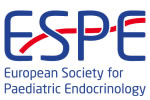hrp0089p2-p205 | Fetal, Neonatal Endocrinology and Metabolism P2 | ESPE2018
Auxological Catch Up Growth and Evaluation of Spontaneous Motility in the Term Newborn Small for Gestational Age Employing the Prechtl Assessment of General Movements
Lucaccioni Laura , Talucci Giovanna , Leo Francesco , Ciancia Silvia , Russo Giovanna , Ferrari Fabrizio , Iughetti Lorenzo
hrp0089p2-p259 | Growth & Syndromes P2 | ESPE2018
Unusual Case of Combination of Beckwith-Wiedemann Syndrome and SHOX Gene Deficiency
Cassano Gilda , Osimani Sara , Pajno Roberta , Pitea Marco , Partenope Cristina , Russo Silvia , Pozzobon Gabriella
hrp0089p3-p310 | Pituitary, Neuroendocrinology and Puberty P3 | ESPE2018
Poland’s Syndrome and Hypogonadotropic Hypogonadism
Stancampiano Marianna Rita , Meroni Silvia Laura Carla , Lascio Alessandra Di , Gianninoto Moira , Russo Gianni
hrp0089p1-p236 | Sex Differentiation, Gonads and Gynaecology or Sex Endocrinology P1 | ESPE2018
Identification and Analysis of the Genetic Causes of Premature Ovarian Failure (POF) in a Cohort of Adolescent Girls
Rita Stancampiano Marianna , Laura Carla Meroni Silvia , Di Lascio Alessandra , Gianninoto Moira , Russo Gianni
hrp0089p3-p362 | Thyroid P3 | ESPE2018
Graves’ Disease in a Pediatric Population: Results from the Last 17 Years at a Pediatric Endocrinology Unit
Carvalho Fabia , Paredes Silvia , Miguel Gomes Maria , Martins Sofia , Marques Olinda , Antunes Ana
hrp0086rfc11.7 | Thyroid | ESPE2016
Secondary Thyroid Cancer among Childhood Cancer Survivors: A Single Institution Experience
Muraca Monica , Bagnasco Francesca , Caruso Silvia , Morsellino Vera , Haupt Riccardo , Cabria Manlio
hrp0086p2-p161 | Bone & Mineral Metabolism P2 | ESPE2016
Identification of Predictor Factors of Growth Outcome in Children with Hypophosphatemic Rickets
Marin del Barrio Silvia , Sancho Paula Casano , Naderi Ruben Diaz , Cots Jordi Vila
hrp0086p2-p263 | Diabetes P2 | ESPE2016
The Role of 24-h Ambulatory Blood Pressure Monitoring in Children and Adolescents with Type 1 Diabetes: Early Experience of a Single Centre
Predieri Barbara , Bruzzi Patrizia , Bianco Valentina , Spaggiari Valentina , Mazzoni Silvia , Cattelani Chiara , Iughetti Lorenzo
hrp0086p2-p287 | Diabetes P2 | ESPE2016
Diabetic Ketoacidosis Risk Factors in the Initial Presentation of Type 1 Diabetes Mellitus in Children and Adolescents
Silva Silvia , Ferreira Lia , Aires Sofia , Freitas Joana , Oliveira Ma Joao , Cardoso Ma Helena , Borges Teresa
hrp0086p2-p433 | Gonads & DSD P2 | ESPE2016
46,XY Complete Gonadal Dysgenesis with Late Diagnosis
Mladenov Vilhelm , Andonova Silvia , Savov Alexey , Hachmeriyan Mari , Popova Ralitza , Iotova Violeta



